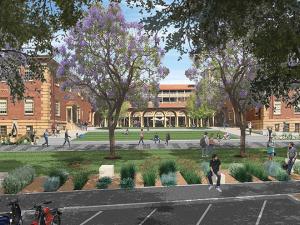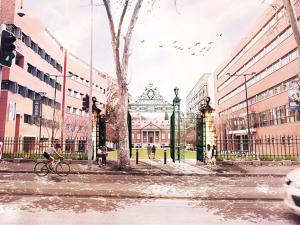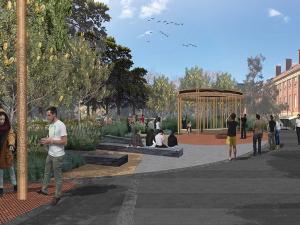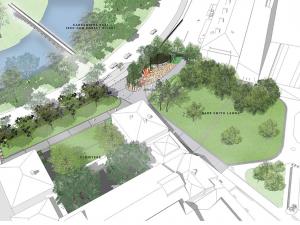Kaurna culture to be showcased in campus transformation
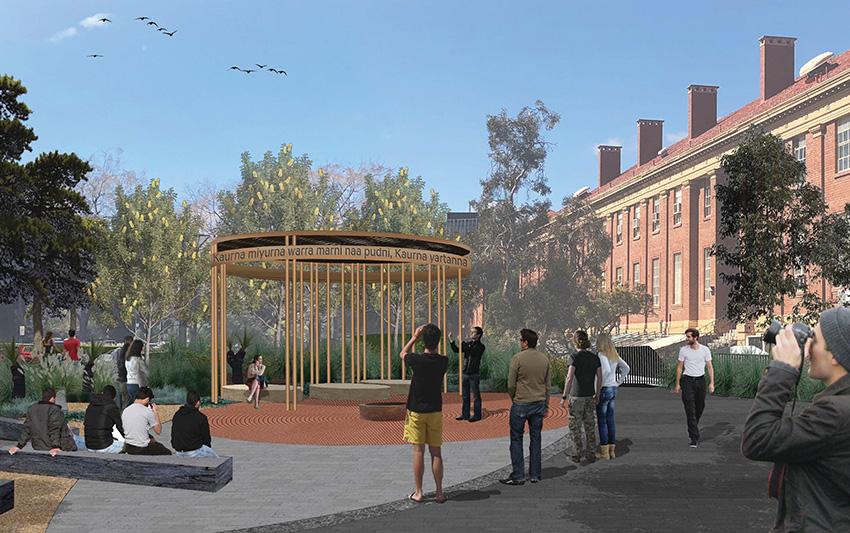
Artist's impression of the Kaurna Learning Circle.
A Kaurna Learning Circle, Kaurna walk and a Heritage walk will become new features of the University of Adelaide’s iconic outdoor spaces in a transformation of the North Terrace campus.
The transformation represents the next phase of significant infrastructure projects on the campus.
As part of the work, the University will also restore a set of much-loved gates to their original historic location.
Vice-Chancellor Professor Peter Rathjen says: “Delivering on commitments made in the University’s new strategic plan, Future Making, we will create a reinvigorated, welcoming campus that engages students, staff, alumni and the broader community, helping to achieve our aim of becoming part of the ‘beating heart of Adelaide’.
“The University of Adelaide is located uniquely in a beautiful and affordable city. This provides us with an opportunity to engage more deeply with the life of the city, bringing together learning, research, culture, entertainment and sport in Adelaide’s heart.
“Our physical presence – opening up the University and making us more inviting to the community – represents the prominent and embedded role we play in our State.
“Through our campus transformation, we will acknowledge the Kaurna people and culture, by recognising Kaurna country on which our campus is built, as well as telling the University’s own story of history, excellence and inclusion. These changes improve our connectivity to the city, to our heritage and to Kaurna culture, and will help to provide a direct entrance from our campus to the nearby Lot Fourteen innovation precinct,” Professor Rathjen says.
Key features of the campus transformation include:
- Creating a north-south Kaurna walk across campus, with each gate entrance renamed in Kaurna language, and establishing a Kaurna Learning Circle that can be used as a meeting place and ceremonial space – created in consultation with Wirltu Yarlu Aboriginal Education and Kaurna cultural advisers.
- Restoring the Mitchell Gates (currently opposite the University Footbridge) to their original location on Frome Road. The gates were built specifically for this location in 1933, acting as a “window” between the old Barr Smith Library entrance and the Adelaide Botanic Gardens. In their restored location, the gates will also act as an entrance from the University to Lot Fourteen.
- Creating a Heritage walk across campus, helping to celebrate the University’s history of excellence.
- Collaborating with SA Heritage to open sections of the University’s perimeter fence to create permeable and welcoming spaces for the community. (see below for The Story of the Fence and the Mitchell Gates).
- Establishing a garden space near the Mawson building, directly opposite the new Adelaide Botanic High School. This will include a Geology Garden that will celebrate South Australian geology and its role in economic development, and will be used as a teaching resource.
- Extending the Barr Smith Lawns north by removing a number of car parking spaces on campus alongside Victoria Drive, helping to restore the original University vistas from the River Torrens side.
- “Outdoor rooms” defined by vegetation, that can be used as teaching, study and social spaces.
- Improving pathways, pedestrian access, green space and shade, and adding more South Australian vegetation and flowering trees.
The University has consulted widely on plans to transform its North Terrace campus.
“The next phase of our campus redevelopment builds on the outstanding work already done to refurbish the University’s historic Cloisters precinct, including the addition of the new UniBar and various improvements to Union House,” says Professor Alan Peters, who is Head of the University’s School of Architecture and Built Environment.
“What we have seen with those spaces is an increased relevance to our community – students, staff and alumni – as well as to the broader community of Adelaide. Hugely popular during the Fringe this year, the Cloisters and new UniBar have remained popular ever since.
“Through the next phase of our major campus transformation over the coming months and into the future, we will see the University of Adelaide becoming a more attractive and welcoming place for people to work, study, visit, socialise, share ideas, and play, while embracing and showcasing our cultural and Kaurna heritage,” Professor Peters says.
The inclusion of Kaurna culture as a key part of the campus transformation is among the actions outlined in the University of Adelaide’s Reconciliation Action Plan, Yangadlitya (translating to “for the future”). This highlights the University’s commitment to becoming a space more welcoming of Indigenous cultures, and giving students and staff the opportunity to learn more about Aboriginal Australia and its ongoing role in contemporary society.
The Story of the Fence and the Mitchell Gates
The perimeter fence that currently encloses the University of Adelaide’s North Terrace campus was once owned by the City of Adelaide, having been built in 1883 around Victoria Square.
By 1901, the City of Adelaide had decided to remove the fence, as it was considered a barrier to members of the public entering Victoria Square.
In 1928 the City of Adelaide and the University of Adelaide agreed to relocate the fence to the campus grounds. The fence was physically moved to the University of Adelaide in 1933 and installed along the lower level of the University’s North Terrace campus, which at the time included the Jubilee Oval.
Now 86 years later, and with SA Heritage approval, the University of Adelaide is able to open sections of the fence to help improve the community’s access to the campus. These sections will be kept in storage until a new, suitable home can be found in collaboration with SA Heritage and the City of Adelaide.
Professor Peters says: “It was in 1933 that the beautiful and ornate Mitchell Gates were built. These gates connected the University to Frome Road and provided a direct line of sight between the old entrance to the Barr Smith Library Reading Room and the Botanic Gardens.
“In the early 1960s, to make way for a building that no longer exists on campus, the Mitchell Gates were moved to their current location overlooking the University Footbridge.
“As part of our commitment to heritage at the University of Adelaide, we will return the Mitchell Gates to their original location on Frome Road. There, the gates will be restored to their former glory and will form a key access point to the new east-west Heritage walk. The gates will also provide a direct entry to and from the University and the Lot Fourteen innovation precinct,” Professor Peters says.
Work on the next phase of the campus transformation has now begun, with some sections to be completed prior to Fringe and Festival season 2020. Further work will continue from 2020 onwards.
Media Contact:
David Ellis
Deputy Director – Media and Corporate Relations
The University of Adelaide
Mobile: +61 (0)421 612 762
david.ellis@adelaide.edu.au

